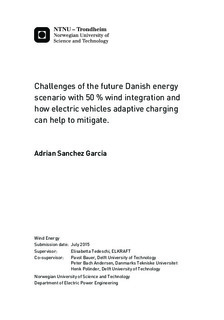Challenges of the future Danish energy scenario with 50 % wind integration and how electric vehicles adaptive charging can help to mitigate.
Master thesis
Permanent lenke
http://hdl.handle.net/11250/2368179Utgivelsesdato
2015Metadata
Vis full innførselSamlinger
- Institutt for elkraftteknikk [2443]
Sammendrag
Denmark aims for a 50% wind integration in 2020. In the current scenario, wherewind represents around 34% of domestic consumption, mothballing of conventionalpower plants and heavy dependency in interconnection lines is already the trend.One of the strategies from the Transmission System Operator is to integrate a bigvolume of flexible loads to adapt to wind production and mitigate some of its drawbacks. EVs, even when a significant increase is expected in the following years, willnot represent a volume of consumption that can really impact the load curve by2020 and this type of response will rely in the short term in other flexible loads likeHeat Pumps.Due to its configuration and advanced technology, EVs can participate to otherservices vital to the correct operation of the Electric Power System as it is provisionof frequency reserves to maintain balance between consumption and generation.This work presents a solution using the adaptive charging capabilities of an EVto get the best respond in both the day-ahead market and the regulation market.The adaptive scheme will achieve: lower price for purchased electricity in the dayaheadmarket, with higher levels of wind energy penetration, and the possibility toparticipate to the frequency regulation market and get revenues. All this featuresare gained without affecting the normal operation of the vehicle. Two differentconfigurations for the battery of the EV are compared in this work: unidirectionaland bidirectional.A fleet of 400 EVs have been modeled based on statistical survey data for EVsusers driving profiles in weekdays and weekends. This fleet is managed by the figureof an aggregator who purchases electricity in the day-ahead market and bid onthe frequency regulation market. The reference charging profile is a non-controlledconsumption scheme of plug-and-charge. This reference model is compared firstwith a basic adaptive models based on weight coefficients varying according to theState of Charge of the battery and the level of wind penetration. Later on, theadaptive model is optimized, following the same indicators, seeking to maximizewind penetration while bidding to frequency regulation market the most numberof times. The optimization algorithms used are Gradient Search, Genetic andDifferential Evolution. The decision factor for the adaptive charging strategies is theforecast wind penetration signal with is the coefficient between the level of forecastwind production and the level of forecast consumption. The idea behind usingthis signal is that it will yield typically lower cost of electricity and high net windpenetration. Allowing high net wind penetration will reduce the presence of energyfrom other generation facilities and thus the CO2 content in the battery charge.Results show that the owner of an EV with bi-directional capabilities and GeneticAlgorithm can reduce the final expenses on the EV by 20% in one year. If GSA isused instead, 36% more wind energy will be integrated in the vehicle. In addition, becausecurrently upward regulation is provided by coal and gas fired units, 60% of thecurrent emissions by providing this service could be cut with a GSA charging scheme.
